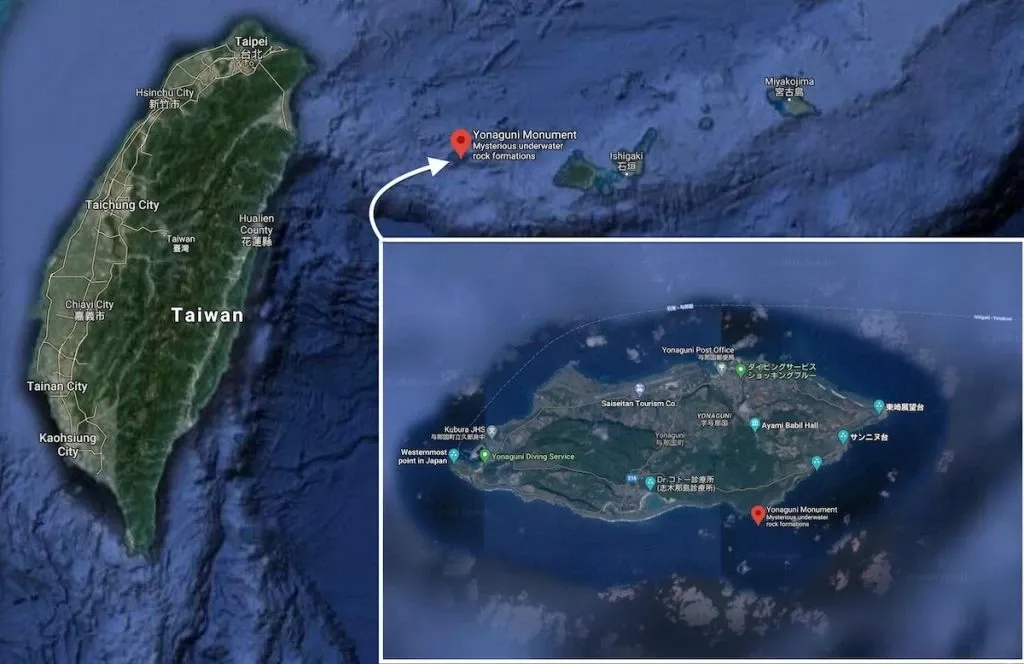The Yonaguni Monument is an enormous underwater rock formation that covers an area of 60 by 50 meters. It was first discovered in the mid-1980s by a scuba diver looking to observe hammerhead sharks. Pseudoarchaelogists believe it to be a monolith carved by man thousands of years ago.
Discovery
The Yonaguni island area is a popular scuba diving destination. Many would say it’s a must-see when diving near Okinawa. Now, divers travel to explore the mysterious Yonaguni pyramid-like structure and its surrounding artifacts.
It was actually by “accident” that Kihachiro Aratake discovered what some scientists call “the archaeological find of the century.” He discovered the mysterious find in 1986 while diving off the coast of Yonaguni Jima, searching for a new spot to view hammerhead sharks. However, he inadvertently strayed outside of the designated safety zone. In front of him lay a massive stone structure on the ocean floor at a depth of 35 meters.
He explored the monument and was in awe at how colossal it was. Due to the heavy encrustation of coral, it was difficult to determine what it was. Curious, he encircled it, again and again, taking photographs before returning to shore.
Initial Study
Masaaki Kimura, a marine geology and seismology professor at the University of Ryukyus, spent years studying the site. He observed and collected data to discover an answer. While his findings were profound, counterarguments, and doubt ensued.
To this day, many divers have visited the site to form their conclusions. Is it an underwater city that once housed an ancient lost civilization? Or is it a rock formation that nature built?
The answer, beyond a shadow of a doubt, has yet to be confirmed.
Where is the Yonaguni Monument Located?
The site is off the south coast of Yonaguni, an island in Japan’s southwest corner. The island itself is about 70 miles from Taiwan and features lush green wilderness and sandy shores. Divers come from all over the world to witness the ancient site and hike around the beautiful island. The coordinates are 24°26′09″N 123°00′41″E
Theories
Some believe that the monument is a human-made pyramid structure bearing evidence of a lost ancient civilization. It was even referred to as the “Japanese Atlantis.”
Masaaki Kimura spent over 15 years studying the site. He is convinced that it was man-made, suggesting that ancient people once lived where it stands. It’s said to be evidence of the , long since submerged following a severe hurricane.
During his many dives to the site, Kimura gathered substantial evidence that man, not nature, formed the ancient structure. He noted several specific artificial features that supported his theory. These features include marks from tools, a retaining wall, a (suggestive) road, drainage canals, gates, stairways, and two carved monuments shaped like turtles.
Kimura also found the suggested remains of tools made from stone and a massive relief carved with animals.
Kimura’s findings concluded with:
“It is hard to believe nature would have left such a clear outline.”
Masaaki Kimura
Kimura ascertains that his research and Yonaguni Island submarine topography show specific evidence of an ancient city lost to the sea. He also found several other constructions. These include a series of smaller temples, a possible stadium, and defined road structures to connect them. In addition to that, recovered tablets (called the “Okinawan Rosetta Stones”) seem to suggest evidence of the ancient city’s existence.
Kimura’s evidence initially led him to conclude that the city was over 10,000 years old. Later research led him to fix his estimate to be in the range of 2,000-3,000 years old.
The Counterargument
Skeptics generally dispute any speculation of ancient submerged cities, and the mystery of this site is no exception.
Dissenters say the straight edges of the monument resulted from the natural stratigraphy of sandstones. These often will look like a straight line, straight enough to be human-made.
, a math and science professor at Boston University who dived the site stated:
“Isolated portions of it look like they’re man-made, but when you look at it in context…you see how, in this case, fine sandstones split along horizontal bedding plains that give you these regular features.”
Robert Schoch
In other words, the straight lines of the formed structure could indicate nature’s natural process of erosion. After all, nature can create some beautiful anomalies.
Schoch adds that the island features several tombs of uncertain age (but clearly ancient) that are similar to the Yonaguni Monument. The tombs would suggest that the people could have mimicked the natural design or modified a natural structure with their hands and tools. However, it doesn’t mean there is a city buried underwater.
Other theories speculate that the formation was a foundation for a since-destroyed building or even a quarry for cutting stones. As Schoch put it, “Possibly the choice between natural and human-made isn’t simply either/or.“
As for its age, Kimura’s original “10,000-year” estimate inspired doubt, simply because of its improbability. Some argue that it’s highly unlikely that such an ancient people would have the means to build such a structure. At any rate, the design and construction would be too complex and challenging for any civilization to accomplish.
Preservation of the Yonaguni “Ruins”
The Yonaguni Monument has captivated many scholars’ interests over the years. However, it is not officially considered an important cultural landmark. The doubt and conflicting theories surrounding its origins are enough not to merit any government preservation efforts. Instead, the responsibility lies with the scholars and other individuals who work on the site.
A Continuing Mystery
Just like the lost city of Atlantis, Japan’s Yonaguni Monument will likely always inspire skepticism. Any evidence found can only support speculation and often generates a counterargument.
However, the site’s mystery adds to its appeal because sometimes it’s best not to be sure. Instead, diving into the unknown presents a much more fulfilling challenge.





